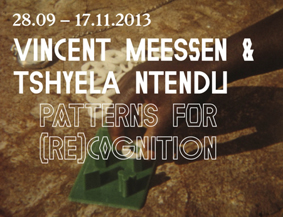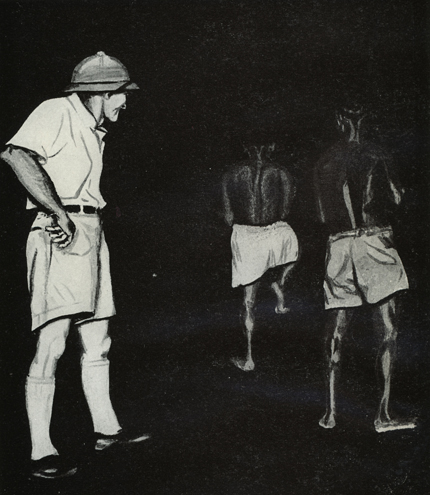Many artists work or have worked about the colonial thematics. I need to mention Vincent Meessen now, because he has an excellent exhibition in Ghent, running until November 17, 2013. Vincent Meessen has been working for years around the thematics of colonialism, with movies like The Intruder, N12°13.062’/W001°32.619, and Vita Nova to which I post a link to the side.
His exhibition “Patterns for (re)cognition” in Ghent gathers three aspects of the abstract: a modular construction defining the space, the abstract paintings of Tshyela Ntendu together with an analyses of how he played with different writings of his name(s), and footage of cognitive psychological tests applied to subjects of Congo, the old Belgian colony (until 1960). The shapes of the construction elements in the space are based on the shapes used in the cognitive tests. The abstract paintings on the walls are good. The complete picture holds neatly together. I would like to show it to you but haven’t found a publication with pictures yet.
But it is the footage of the cognitive psychological tests that really got to me. The footage, 16mm, organised in 3 projections in loop, is from the late 1950ies and depicts a series of tests run by the French psychologist André Ombredane. In each image, we see one or more white men neatly dressed in colonial costumes (beige suits, helmets) next to Africans dressed in rags. There are no women in the pictures. The white man expects something of the black man; he has to put little squares, triangles, crosses etcetera into a hole of the right shape. On a different movie the black man has to recognize the same pattern of lines among a series of similar pictures. These are ‘tests’ but we recognize them as the toys we grew up with, toys we played with on a daily basis, training our ‘logical thinking’ from babyhood. The amazing thing is, that it seemed a very difficult task to the Congolese men in question; I had never expected such deep cultural differences between both our cultures. Our psychological foundations prove to be very very different. Watching the footage was alienating and, most of all, questioning. It could be interpreted in a racist way. This makes me think of an episode, twenty years ago, when I got angry with a family member. He was working for a pharmaceutical company that had to close their African production branch, “because Africans are not able to put pills in boxes”. You see why I got angry, but today I wish I had asked him what he meant by that. I might have learned something. The psychological cognitive tests were taken for practical purpose: the aim was to find out and to categorize which ‘workers’ could be useful in what domain: administration, factory, … so they could be defined as a little cube, a cross, triangle or circle, and fit in some Western little boxes. Check out the exhibition: 28/09 – 17/11/2013 Kiosk gallery Louis Pasteurlaan 2 9000 Gent


